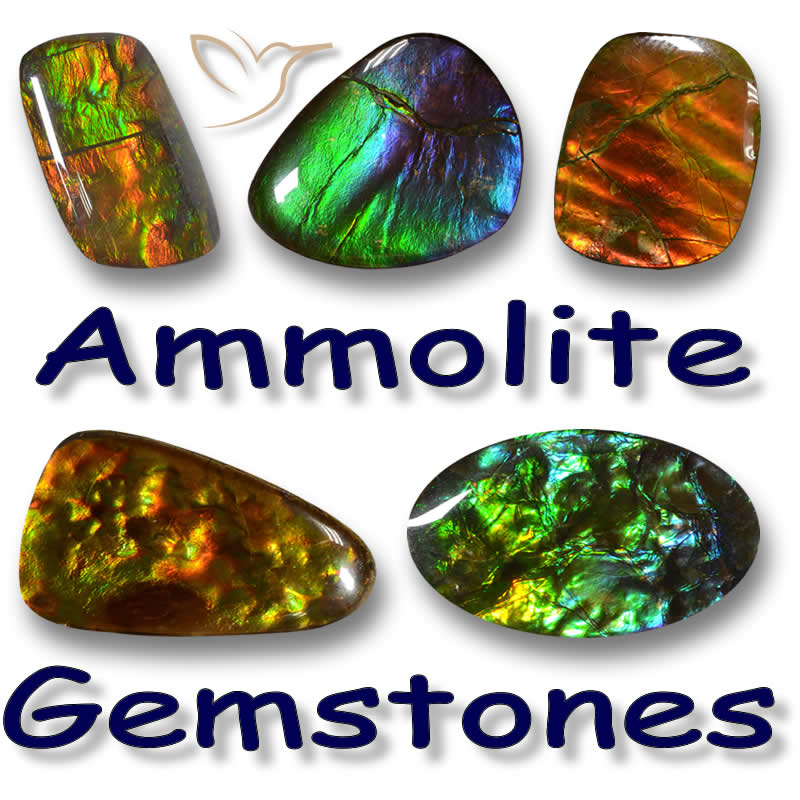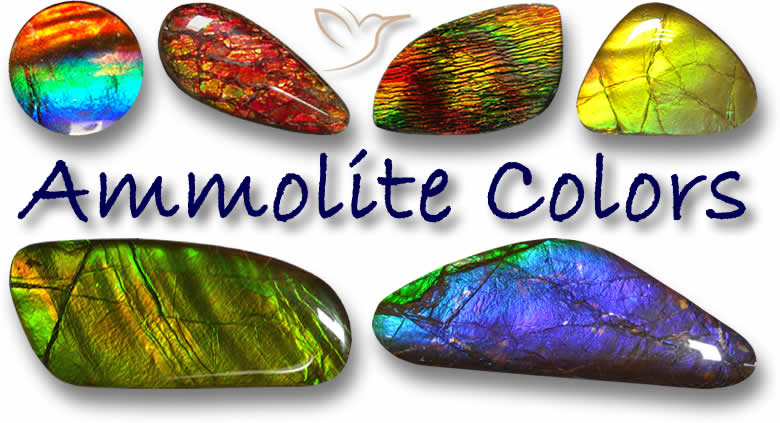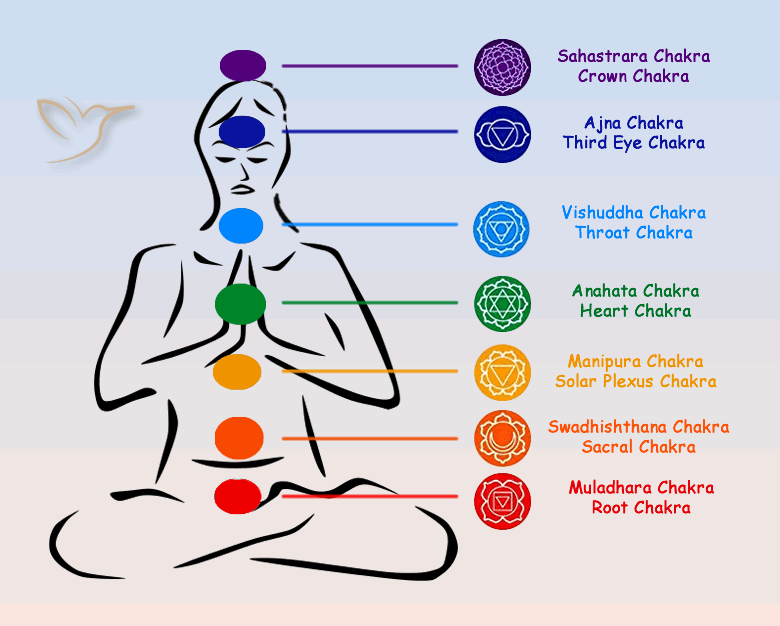What can I find in this article?
- Ammolite Colors
- Ammolite Species
- Ammolite Patterns
- Spiritual Meaning of Ammolite
- Ammolite and the Chakras
- Health Benefits of Ammolite
- Ammolite Price
- Ammolite Discovery
- Where is Ammolite found?
- How is Ammolite formed?
- Can Ammolite be treated?
- What jewelry is Ammolite suitable for?
- Did you know? Interesting facts about Ammolite
- How to care for Ammolite.
- How to tell a real Ammolite
- What is so special about an Ammolite?
- Ammolite - Gemological Properties
Ammolite Gemstone Information

Introduction
The iridescent opal-like Ammolite is one of the few organic gemstones available. Most gemstones are minerals but some, the most famous being amber and pearls, are organic in origin. This means that they formed from a biological process rather than a mineral process. Amber is made from hardened tree sap from pine trees over a period of between 2 and 10 million years, pearls are formed inside oysters and other mollusks over 5 to 20 years.
Ammolites are created from the crushed shells of ammonite marine animals over a period of around 70 million years!

Ammolites can come in almost any color you could imagine and often all on the same gemstone. Green and red is the most prevalent color whilst blue and purple are more rare occurrences.
The most valuable ammolites show lively colors in two or three hues with each color having a good coverage of the gemstone's surface.
The colors should be visible as you turn the stone in all directions and should be able to be described as vivid, bright, brilliant, reflective or dazzling.
What causes the color in Ammolites?
Ammolites are made up of a variety of chemicals including aluminum, chromium, copper and iron but unlike other gemstones this does not cause the wide array of colors that they display. The color is caused by interference, a bit like what you have probably seen in soap bubbles or oil in a puddle of water. The surface of the ammolite reflects a variety of beautiful colors when illuminated by natural or artificial light. What color it shows depends on the thickness of the ammolite - we are talking of thicknesses of only a few microns but it has a huge effect on the colors we see. Thinner surfaces have that bit more distance to travel than the slightly thicker layers, in addition the waves of light from these different depths interfere with one another producing all the different color on display. Thicker layers produce the reds and greens and are more durable, thinner layers show off the blues and violets and are more delicate and liable to fracture so are less common and more valuable. Each color in ammolite represents a different layer of the gem material.
All ammolites are a single species or variety of the fossilized shells of an ancient mollusk called an ammonite which in turn were comprised of the mineral aragonite, which is the same material found in pearls, mussels and abalone. Sometimes they are referred to as Calcenite or Korite, which are trade names for this gemstone, or gem ammonite and aapoak, a Native American term meaning crawling stone.
Like the similarly colored opal, ammolites can be described as unique but often have characteristic patterns which are shared by enough examples to almost be described as a variety. Some of the more well-known pattern varieties include:
- Stained Glass
- Which resemble the familiar panes of multi-colored glass
- Dragon skin
- Named after the scaly skin of these mythological beasts
- Cobblestone
- With regular but uneven rows like the streets of old European towns
- Paintbrush
- With their broad strokes of color
- Lava
- With rivers of red lava flowing through a green background
- Sunset
- With their red and orange hued landscapes
There are many more patterns which describe the particular ammolite and usually come from one of two geological layers found in the Bearpaw Formation in the Rocky Mountains of North America, the Blue Zone and the K Zone.
Long before Ammolite was marketed to the world as a gemstone it was known to the Blackfoot tribes of Canada as 'Iniskim' or the buffalo stone and it was believed to have the power to attract buffalo during the time for hunting.
The traditional Blackfoot tribal lands stretched from the Great Plains to the Rocky Mountains in what is now present-day Alberta in Canada and Montana in the USA. An old tale tells of a period of time when the tribe had no luck in hunting buffalo and the cold winter was drawing in. If they did not find food they would starve. One of the tribeswoman had a dream about a magical gemstone that would draw the buffalo.
The next day she was collecting firewood when she heard a song coming from a cave. She entered the cave and found a rainbow colored stone which she took back to her village. Not long after a herd of buffalo came to feed not far from their camp and the hunters could get enough food to feed their people. Since then the stone has been regarded as a powerful amulet to provide all the needs for life and to bring good luck.
The power of this gemstone comes from a variety of sources. It is formed by the fossilization of shells of ammonite mollusks - a prehistoric sea creature similar to a nautilus or squid - and these shells contain aragonite, a mineral which increases energy, boost self confidence and relieves stress. The same mineral makes up the lining of oysters and abalones which creates mother-of-pearl and pearls so incorporates their spiritual powers too.
The ammonite mollusks that are the source of all ammolites had spiral shaped shells and this is a very ancient and powerful configuration which can be found in archaic artwork of Europe, Asia, Africa, the Americas and the Aborigines of Australia. It represents many aspects of life including rebirth, energy, seasons, growth, journeys, development and many others.
The energies of this gemstone will help you harmonize your environment, bring you prosperity and good fortune, protect you from physical and spiritual harm and change negative energy into positive energy.
Chakras are the energy centers in your body also referred to as Qi or Prana. There are seven Chakras throughout the body each influencing a particular physical, emotional or mental state and each has an associated color. The seven chakras are as follows, Crown linked with the color purple, Third Eye (indigo), Throat (blue), Heart (green), Solar Plexus (yellow), Sacred (orange) and Root (red).

Ammolite has been called the "Seven Color Prosperity Stone" because this gemstone can incorporate all seven colors of the chakras.
It can influence them all in a positive way or if one particular color is dominant within your ammolite it will influence that particular chakra more than the others.
- Red = love
- Orange = creativity
- Yellow = prosperity
- Green = knowledge
- Blue = good health
- Indigo = peace
- Violet = growth and energy
Ammolite will help detoxify and purify your body, give you an energy boost and increase your stamina. It can help regulate your heart beat and stabilize blood pressure. It will increase your mental powers, aid creativity, lift libido and fertility and enhance the clarity needed for decision making.
We are often asked how to use gemstones for spiritual or health benefits and while we are certainly not experts in this field we have gained some experience and knowledge. Of course wearing the gemstone as a piece of jewelry is the easiest way for the crystal to influence your body.
Alternatively they can be placed in your purse or pocket and used as a touchstone throughout the day. Hold crystals or place them in your lap while meditating. Easiest of all, just lay down with crystals on your body, lined up with the chakra points if possible. Put them in the bath (check the particular stone is impervious to water). Decorate your home with crystals, certain crystals boost the working environment so keep them on your desk, other help you relax so keep them in the lounge or living room.
Ammolite should be cleaned every week to keep it at its maximum potential. You can do this by running the stone under warm water and drying it in the sun for about half an hour. Ammolite is quite a delicate gemstone in many ways so take a bit of care with how you treat it.
Ammolite Price List |
||
| Color | Weight range | Price range / USD |
|---|---|---|
| All Colors | 1ct and more | $5 - $60/ct |
With colored gemstones the most important factor in the price is the color and this is no different for ammolites. Other factors do play their part of course and personal taste in color can never be ignored but there are a few guidelines we can follow.
We can grade an ammolite from good to bad in a fairly simple way by saying the top quality ammolite will display three bright colors with good coverage of the stone and with the color being visible from all angles. Then we can move down from this high grade to two or fewer colors being shown, colors disappearing at shorter angles, less vivid coloring down to virtually no coloring at any angle!
In addition, again a little bit like opals, other more subjective issues enter the equation and what one person may value highly another will not appreciate. A full spectrum of colors rather than 2 or 3 dominant colors, rare pinks and blues, unusual or preferred patterning, depth of color, flashes of light, blemishes and cracks in the surfaces all play their part in pricing this diverse gemstone.
All gemstone quality ammolites come from the Rockies in Canada so the origin of this gemstone does not really affect the price.
Ammolite may have been used by Native American tribes for decoration and in scared ceremonies but the gemstone was not revealed to the world until it was discovered by the Geological Survey of Canada in 1906. It circled the world of collectors and geologists for decades before a couple of paleontologists searching for fossils discovered some brightly colored ammonite fossils.
These two men, Pierre Pare and Rene Vandevelde, mined the ammolite in the mountains and sold it in local towns but soon realized that they had something special in their hands. They lobbied successfully in 1981 for ammolite to be officially accepted as a gemstone by the World Jewelry Confederation and began their mining business.

All ammolite gemstones are sourced from one place, the Rocky Mountains of Alberta in Canada. Just two companies, Aurora and Korite, produce gem quality material and they cut and polish on site so very little rough stones ever enter worldwide lapidary markets. Sometimes, gem quality ammolite can be found by alluvial miners in the fast and cold rivers that flow down from the peaks of Alberta and Montana in the USA but barely enough to warrant a mention.
Ammonite shells can be found in many other parts of the world and so can fossilized remains with some iridescence in places such as England, Morocco and Madagascar but these examples are generally too thin and too weakly colored to be on any value in the gemstone industry.
How this unique gemstone came to be is a great story. 100s of millions of years ago the world's oceans were teeming with life and one of its most successful animals was the ammonite, a squid or octopus like creature which lived inside a spiral shell a bit like the modern nautilus. Those fossilized spirals that are quite often seen in museums are ammonites.
Ammonites were possibly the smartest things in the ocean for a 100 million years or more but were wiped out by the same meteor which caused the extinction of the dinosaurs about 65 million years ago. As they died their shells sank to the bottom of the oceans where most were crushed by pressure and time but others sank into sediments to become fossils as the sediments around them turned into rock. 70 million years ago, to the east of what is now the Rocky Mountains lay a huge ocean (the Western Interior Seaway) and millions upon millions of ammonite shells sank to the bottom of this ocean and they were covered in silt which flowed off the mountains and into the sea. This silt and the ammonite shells beneath turned to stone over millions of years and were then moved up into the Rockies by plate tectonic activity.
There they lay beneath what are now Alberta, Saskatchewan, Montana and Utah in the Bearpaw formation waiting to be discovered. Of course most of the remains is just broken ground up shell with just the occasional whole fossilized ammonite and even more rarely a thin layer of iridescent gemstone.
Ammonite (the sea creature - the names are too similar aren't they?) contains aragonite which is the same material which makes the mother of pearl lining of oysters, abalones and mussels and also the pearls themselves. This almost iridescent substance is nacre and this is trapped during the fossilization period and helps create the colors in ammolite (the gemstone).
Ammolite is a thin layer of fossilized shell usually attached to a darkly colored shale or rock backing and when we say thin, we mean thin, often less than one millimeter. Very, very rarely a piece of ammolite can be cut and polished still attached to its natural base with no more further treatment other an epoxy coating to prevent splitting but most material is turned into doublets or triplets before being sold.
Doublets and triplets are very common with opals and the process means these relatively soft and delicate gemstones can be protected and last a long time. A doublet basically means the sheet of ammolite is layered onto a host rock while a triplet also has a transparent cover laid on top for extra protection.
The process carried out on ammolite in Canada is a secret technique developed by the Korite company, probably using spinel or quartz as a covering which raises the Mohs rating for ammolite from around 4 up to nearly 8 which is a dramatic strengthening of this delicate gemstone.
Natural Ammolite gemstones are rated 3.5 to 4.5 on the Mohs hardness scale so without being protected by doublets or triplets would not make any sort of jewelry. However with such protections in place this gemstone can be turned into almost any type of jewelry although an extra precaution of protective settings would be a good idea, especially in a ring setting.
Read our detailed article on the Mohs hardness scale here
The unique and dazzling colors and patterns as well as the free form shapes and large sizes found in ammolite really lend them to being turned into eye-catching one-of-a-kind pendants, brooches, necklaces and earrings.
- How did Ammolite get its name?
- Ammolite comes from Ammonite (the sea creature) which in turn got its name from the Egyptian god Ammon or Amun who is usually depicted as a ram-headed man. The ram's horns looked like fossilized ammonites and historian Pliny called them ammonis cornua (horns of Ammon).
- It is said that the original discus used by the ancient Greeks in their Olympics was in fact a fossilized ammonite.
- Ammolite is one of only three gemstones that have been classified as a true gem by the World Jewellery Confederation in the past 300 years along with Tanzanite and Sugilite.
- Ammolite Gemstones are Fossils?
- There is an argument amongst geologists and gemologists that ammolite is not a mineral like most gemstones and is not really an organic gemstone either (despite what I wrote earlier!) but it is in fact a fossil. It does not have any exact chemical formula like true minerals but for the moment we will stick to it being classified as an organic gemstone.
- In India, ammonite fossils are identified with the god Vishnu and are used in various ceremonies. They are mostly collected in Nepal, from the bed of the River Gandaki where it cuts through Jurassic sediments.
- Buying Ammolite could be a good investment
- Korite, the largest producer of Ammolite says that deposits of the gemstone will be exhausted within 20 years and it Ammolite jewelry has increased in value by 300% in the past 10 years
- Like Tanzanite, Ammolite has been called a "generation" gemstone because deposits will be used up within one generation.
- Currently only two acres of land is being mined per year but will expand to eight to keep up with worldwide demand. Production is expected to double from the present eight million carats per year.
- Ammolite is not really sold by carat weight.
- Ammolite is usually combined as a doublet or a triplet for strength and the actual gemstone is really just a thin layer of material (very rare and precious material mind you) so it would be misleading to sell ammolite by its weight. Instead, ammolite gemstones are priced by its size and play of color.
- Ammolite is not an official birthstone or anniversary gemstone (it is too new) but it has links to the Capricorn star sign.
Completely natural Ammolite is rated on 3.5 to 4.5 on the Mohs hardness scale so is way too soft to be used in most types of jewelry however most of these gemstones are assembled as doublet or triplets to increase their durability. Some ammolites which have not been given extra backing or a protective covering may have had an epoxy injection to keep the delicate surface of the gemstone from cracking.
These treatments allow the gemstones to be formed into many types of jewelry with little or no danger of them chipping or cracking but it does mean they need a bit of special care. Doublets and triplets involve glue and backing material so a long soak in water is not a good idea as it can lift the backing or fog up the top crystal layer.
Ultrasonic cleaners and steam cleaners should not be used to clean ammolite because the agitation and high temperatures can cause damage to the bonding material . Clean your ammolite using a soft cloth and only mild soap or detergent if needed.
When storing your ammolites care should be taken to keep them away from any harder materials which may scratch, chip or break them. Keep them in individual cloth bags or boxes for extra protection.

Ammolite is a very valuable gemstone so it will be tempting for someone to try to create a synthetic, simulated or even counterfeit version but as it is fairly new to the market not many have yet appeared. Some gemstones and materials have similarities to ammolite such as labradorite, abalone and paua shell and black opal but are rarely used as a substitute. Some fairly obvious fakes have been circulating but they are quickly spotted as the colors do not alter when the gemstone is moved.
Buying your ammolite gemstones from a reputable dealer is the best way to guarantee you are getting what you are paying for.
When buying an ammolite gemstone you are buying something very special, a gemstone found in one small corner of the world, rarer than nearly all others and forged beneath the ocean for tens of millions of years. The colors are truly unique, shimmering and playful, with every gemstone a one-of-a-kind with a singular pattern to match.
Ammonite shells that have survived the millions of years of movement, heat and pressure beneath the earth's surface make a small fraction of the sea creatures that died all that time ago. Of those that ended up in this small corner of Alberta only 5% have any satisfactory gemstone material and that only comprises a thin layer on the surface of the shell itself. In turn only about 20% of this thin layer is valuable enough to be cut, polished and sold so we can see how rare this wonderful gemstone truly is.
In addition to the gemstone itself, the way it is brought to the world is special too. Rather than exploiting the traditional owners of the land where they are mined, locals are part of the process from digging to cutting to polishing to selling.
The gemstone is the result of extremely hard and expensive work, a full day's toil may produce a bucket's worth of rough stones and an average of one cup of top quality gemstones emerges each day of the year. This gemstone is the result of fossilization but if a fully formed fossil ammonite shell is discovered all machine work is halted so it can be extracted carefully and intact, then transported to the local museum for inspection and cataloguing, before work can recommence.
The finished mining areas are returned to their natural state, every layer of land replaced in order, trees and bushes planted, grasses seeded until you would not know a mining company had been anywhere near. It would be nice if every gemstone mine treated the earth in such an environmentally caring way.
Chemical Formula: |
Calcium carbonate (CaCO3); 3-4% variable mineral traces). |
Crystal Structure: |
Orthorhombic |
Color: |
Gray-brown, multicolored iridescence |
Hardness: |
4 on the Mohs scale (varies in composition) |
Refractive Index: |
1.52 - 1.68 |
Density: |
2.75 - 2.80 |
Cleavage: |
Pinacoidal |
Transparency: |
Opaque |
Double Refraction or Birefringence: |
0.155 |
Luster: |
Greasy to dull; vitreous to resinous |
Fluorescence: |
Ultraviolet light - mustard yellowish |
- العربية | Ammolite Gemstonestones - قوس قزح نادر من ألوان جبال روكي
- 中文 | 菊石宝石 - 来自落基山脉的罕见彩虹
- English | Ammolite Gemstones - A rare rainbow of colors from the Rockies
- Français | Ammolite Gemstones - Un rare arc-en-ciel de couleurs des Rocheuses
- Deutsch | Ammolit-Edelsteine - Ein seltener Regenbogen von Farben aus den Ro...
- 日本語 | アンモライトジェムストーンストーン-ロッキー山脈からの珍しい色の虹
- 한국인 | 암몰라이트 원석 - 로키산맥의 희귀한 무지개 색깔
- Português | Gemstones Ammolite - Um raro arco-íris de cores das Montanhas Rochosas
- Pусский | Аммолитовые драгоценные камни – редкая радуга цветов Скалистых гор.
- Español | Piedras preciosas de ammolita: un raro arco iris de colores de las...






